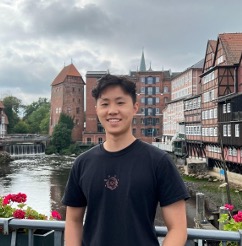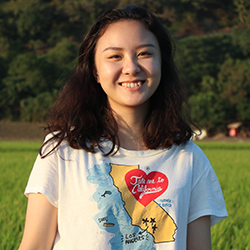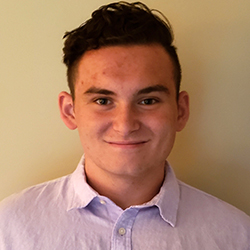ECE Undergraduate Summer Grant Recipients Progress on Research Projects
Supported by ECE research grants, undergraduate students Stephen Cheng, Jennifer Chiang, and Michael Richards devoted the summer to ongoing projects.
Campus is bustling as students gather, fall courses commence, and activities resume. Among the many students who remained on campus over the summer, undergraduate students Stephen Cheng, Jennifer Chiang, and Michael Richards spent the last several weeks collaborating with Department of Electrical and Computer Engineering faculty.
The three students earned funding grants from the department enabling them to continue ongoing research projects through the summer.
“Supporting undergraduate research is a win-win proposition for ECE. Our faculty benefit from the opportunity to work with amazing undergrads on their research interests and the students benefit from gaining exposure to cutting edge research,” said Randall Berry, John A. Dever Chair of Electrical and Computer Engineering at Northwestern Engineering.
 Stephen Cheng
Stephen Cheng
In spring 2022, Cheng, a second-year student pursuing a bachelor’s degree in electrical engineering, began working in the Bio-Inspired Sensors and Optoelectronics Lab headed by Hooman Mohseni, professor of electrical and computer engineering and AT&T Professor of Information Technology at the McCormick School of Engineering.
Cheng, whose research interests include solid state engineering, optoelectronics, and nanotechnology, continued a project this summer focused on testing experimental, high-resistance memristor devices — electrical components which relate change in electrical charge with change in magnetic flux — for use in low voltage systems. When voltage of a significant magnitude passes through a memristor, its nanostructure changes, allowing the device to “remember” the resistance until another significant voltage is passed through it. Memristors also switch states — a significant positive voltage can switch the device to low-resistance state and passing a significant negative voltage can switch the device to high-resistance state.
“Currently, most memristors are experimental devices since not enough is known about their behavior, but they will have potential applications in machine learning, remote sensing, neural networks, and low voltage systems,” Cheng said.
By running different kinds of scans via a setup designed by the Mohseni Lab that passes different voltage pulse patterns through the resistor, Cheng tested memristor switching capabilities and endurance. PhD students Samaneh Ansari, Nathaniel Coirier, and Daniel Timbie helped Cheng with project setup, coding, and troubleshooting.
“The experimental memristor samples that I work with have limited switching capabilities and eventually short circuit, and it is my job to understand how to best optimize their performance,” Cheng said. “I was able to establish a consistent method for switching the memristors between high and low resistance, and the memristors showed a gradual increase or decrease in resistance during retention scans.”
The memristor project has helped Cheng understand the patience involved with research.
“Since I am researching devices that are experimental, there will often be times where nothing notable seems to be happening,” Cheng said. “However, that is just a part of research, and there will also be times where very interesting things are occurring. I like to think of it as digging for treasure.”
Cheng plans to pursue a joint BS/MS degree in electrical engineering and will continue to explore the field of solid-state engineering through courses and work with the NUSolar club.
 Jennifer Chiang
Jennifer Chiang
Chiang, a fourth-year undergraduate statistics student in Northwestern’s Weinberg College of Arts and Sciences pursuing a double-minor in computer science and materials science, continued an ongoing research project within the laboratory of Northwestern Engineering’s Matthew Grayson.
Chiang’s research interests center around applied statistics, such as survival analysis. Using a fit function based on a random walk model recently developed and modified by the Grayson Research Group, she conducted a statistical analysis of more than 200 sets of human mortality data.
“In my research, I analyze the recurring patterns within the tail of the fit residual data which, like other models that researchers have previously used, shows a much faster decay than observed in the tail of the actual population data. More people are predicted to be dead than there actually are at higher ages around 80 years and 100 years, which leads to this recurring trend where the predicted fit deviates from the actual data significantly at those years,” Chiang said. “I am exploring the hypothesis that these patterns were caused by the presence of different sub-groups within the entire population, where the fit parameters of each sub-group come together to form a Gaussian distribution.”
Chiang is using simulated, artificial mortality data she developed to train and improve the program’s fitting abilities and account for the recurring patterns she observed.
Chiang began collaborating with Grayson, professor of electrical and computer engineering, in 2019 as a research assistant. She assisted in fitting the group’s heavy-tail equation onto various datasets, one of which contained data on human mortality.
“This led us to explore the possibility that this new equation could potentially yield better fits to human mortality data than previously well-known and used models such as the Gompertz and logistics models,” Chiang said.
Chiang’s research on mortality curves continued to evolve. In 2021, she earned a Summer Undergraduate Research Grant from Northwestern’s Office of Undergraduate Research for the project “Mortality Data Implications of Pandemics.”
“Overall, this project has helped me better understand exactly what research is and would look like if I were to go on to a graduate program,” Chiang said. “In fact, it has, unexpectedly, helped solidify my decision to apply.”
Chiang plans to apply to graduate programs in statistics this fall.
 Michael Richards
Michael Richards
Richards, a third-year electrical engineering student, spent the summer working in the Center for Quantum Devices (CQD) with director Manijeh Razeghi, Walter P. Murphy Professor of Electrical and Computer Engineering at Northwestern Engineering, and PhD student Lakshay Gautam.
Richards began working at the CQD in October 2021 to explore his research interests in semiconductor materials and devices and photonics — the generation, detection, and manipulation of light waves — related to the creation of semiconductor-based photodiodes (PDs) to detect light in the ultraviolet region.
In conjunction with Gautam’s investigation of solar blind deep-UV avalanche photodiodes in linear and Geiger modes, the goal of Richards’ summer project was to perform structural characterization of III-Nitride semiconductor materials grown in the lab via x-ray crystallography to yield information such as the atom type, spacing of lattice planes, surface morphology, defect type and density, and crystallographic orientation.
Richards processed X-ray diffraction (XRD) scan information using Matlab scripts he created to determine each attribute of the sample. Using both symmetric and asymmetric XRD, Richards analyzed all the III-Nitride samples grown over the course of the summer and determined the mosaicity, mismatch, screw dislocation density, uniformity, and the thickness of metalorganic chemical vapor deposition-grown samples.
“These samples showed great uniformity and the determined values agreed with that found in the literature for previous III-Nitride measurements,” Richards said.
Richards was surprised by how much he accomplished over the summer.
“I learned a lot throughout the school year, but that was dwarfed by what I could accomplish over the summer giving it my full attention. I became extremely comfortable with the equipment, especially the lab's x-ray diffractometer, and the working principles behind them,” Richards said. “My understanding of solid-state engineering was also bolstered by my responsibility to train a visiting student, which involved teaching a lot of the fundamentals behind the technology we are working on in the lab.”
Between the summer project and start of fall courses, Richards joined the Northwestern Institute for Sustainability and Energy Global Engineering Trek to the Hamburg and Köln regions of Germany to learn more about sustainability and energy practices abroad and build professional connections.
Richards plans to pursue a joint BS/MS degree in electrical engineering. As a result of his research experience at CQD, Richards is entertaining the opportunity to further his experience with a PhD in electrical engineering while maintaining a career focus on patent law.
“I will definitely be going on to law school and taking the patent bar exam so that I can pursue my dream of working as a patent attorney,” Richards said. “This will allow me to stay on the cutting edge of technology and to work toward technological progress.”
